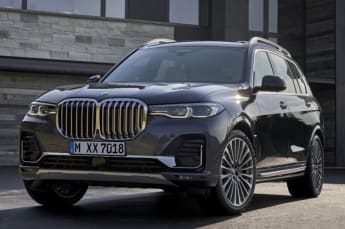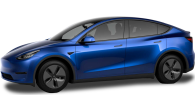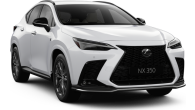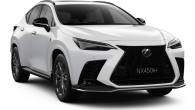Australia has so much to thank America for. The golden arches, a never-ending parade of Kardashians, and Jurassic World: Fallen Kingdom. Not to mention enormous SUVs.
If you want to sell a luxurious family truckster in the United States it better be yuge. And the German ‘Big Three’ has obliged with the Audi Q7, the Mercedes-Benz GLS, and now BMW has joined the party with the seven seat and yes, humungous, X7. Heck, it’s even built in good ol’ South Carolina.
The launch line-up is limited to two variants, the luxury-focused xDrive30d ($119,900 plus on-road costs) and the powerhouse M50d ($169,900). Both powerful, loaded with standard features, and able to carry seven people in the comfort to which they are no doubt accustomed.
BMW X7 2019: Xdrive 30D
| Engine Type | Twin Turbo 6, 3.0L |
|---|---|
| Fuel Type | Diesel |
| Fuel Efficiency | 7.3L/100km (combined) |
| Seating | 7 |
| Price From | $84,150 - $96,690 |
Is there anything interesting about its design?
8 / 10
As the name implies the X7 is the 7 Series of the BMW SUV line-up and suitably limo-like in its proportions. At 5.15m long it’s around 23cm longer overall than the already substantial X5. Not to mention appreciably taller, and lengthier in the critical wheelbase measurement.
.JPG)
In fact, the X7 boasts a greater distance between its axles than its Audi Q7 and Mercedes-Benz GLS rivals, too.
You’re never going to mistake the X7 for anything other than a BMW. The biggest application of the brand’s kidney grille so far gives the car an expression reminiscent of a certain carrot-loving bunny.
.JPG)
It takes some getting used to, but the size is also functional with active air flaps managing the balance between airflow to the engine (closed off at start-up for a quicker warm-up to operating temperature to save fuel) and aero efficiency.
The X7 certainly has presence, due partly to its sheer scale, although the surfaces are tightly wrapped and attention to design detail is obvious.
The narrow headlights are adaptive LEDs (lasers optional) and standard rims are 20-inch alloys on the xDrive30d and giant 22s on the M50d.
.JPG)
A strong character line runs along the flanks with a characteristic swage line drawing the lower part of the body inwards. Which along with the signature ‘Hofmeister Kink’ at the back of the side glass neatly ties it to other BMW models past and present.
The rear end is precisely composed with subtle chrome accents, slim LED tail-lights and dual exhaust openings continuing the premium look and feel.
.JPG)
The interior is awash with primo leather, brushed metal highlights, and top-quality finishes, with the dash dominated by twin 12.3-inch digital displays.
Unlike Mercedes-Benz and Volkswagen, BMW has made no attempt to join the two together in a widescreen display. The sleek instrument cluster is the same configurable TFT unit already used in the X5, 3 Series, and Z4, and no-doubt progressively rolling out to the rest of the brand’s line-up.
Although beautiful, the central colour media screen is not, repeat not, a touchscreen, so audio, nav, vehicle settings, audio, and everything else managed through it must be accessed via the ‘iDrive’ rotary controller.
The centre console and major touch-points will be familiar to any current BMW owner, which means design restraint expressed through broad, flowing surfaces and simple shapes. No surprise, execution is pretty much flawless.
How practical is the space inside?
10 / 10
Whether it’s an airline seat, hotel room, or top-shelf SUV, spaciousness equals luxury, right? And the X7 delivers proper, front of the plane, five-star comfort… for seven.
Up front there’s tons of room and storage including a lidded bin between the seats, twin cupholders in the centre console, a generous glovebox and door pockets including an opening for big bottles.
.JPG)
And there are connectivity options all over the cabin, including seven USB ports (type A and C), Apple CarPlay and wireless mobile device charging.
But the next row back is where the wide-open spaces really open up, and the first clue to the space available in the second row is the length of the rear doors. They are huge.
.JPG)
Sitting behind the driver’s seat set for my 183cm position, I enjoyed abundant leg, head and shoulder room. But despite the X7’s ample girth, the centre position would be the short straw option for long journeys given the two outer spots are more carefully sculpted and bolstered.
A fold-down centre armrest houses a lined, flip-top storage box and two fold-out cupholders, there are map pockets on the front seat backs, and large door bins, again including space for large bottles.
Dual adjustable vents and climate control switches are housed in the rear of the front centre console, there are vents in each C-pillar, plus there’s a small oddments tray, 12-volt power and a pair of USB sockets.
Even those in the ‘way-back seats’ have got it made, with access to the third row appropriately civilised, thanks to the second row’s easy, if glacially slow, electric folding mechanism.
.JPG)
Once installed back there I had enough head, leg and toe room for even a moderately long journey. Kids will be swimming in the space available.
Plus, there are broad outer armrests with a cupholder built-in, as well as USB outlets, and (optional) adjustable temperature control in the roof. Not bad, at all.
.JPG)
But, seating for seven is fine. What if you need to carry all their “stuff” as well? And the answer is even with all seven seats upright there’s 326 litres of luggage capacity available, which is a little less than an average compact, five-seat SUV. Enough to hold the large (105-litre) and medium (68-litre) hard suitcases from our three-piece set, with lots of room to stack to the roofline above.
Fold that 50/50 split third row forward (electrically via buttons in the boot or the side rear door openings) and you’ve liberated 750 litres, which means you can add the third suitcase (35-litres) and the CarsGuide pram with hectares to spare.
.JPG)
With the 40/20/40 split-folding second row down there’s enough room (2120 litres) for a cheeky round of indoor golf.
.JPG)
The two-piece (horizontally-split) rear door opens and closes remotely, through the key fob or a ‘Comfort Access’ sweep of the foot under the rear bumper. And the standard air suspension system even allows for ride height adjustment of 40mm to help with loading heavy or awkward things. Plus, there are cargo tie-down shackles at each corner of the cargo floor, as well as a first-aid kit.
Towing capacity for a braked trailer is a hefty 3.4 tonnes, and 750kg unbraked. And all you’ll find under the rear floor is a cargo cover blind because the tyres (on all X7s) are run-flats.

Does it represent good value for the price? What features does it come with?
8 / 10
There are two models in the launch line-up, the stonking M50d at $169,900, before on-road costs, and the xDrive30d, at a slightly more approachable $119,900.
We’ll cover active and passive safety tech, of which there’s heaps, in the safety section later, but the standard equipment baseload is suitably substantial.
.JPG)
Highlights for the xDrive30d include four-zone climate control, leather trim (lots of it), auto adaptive LED headlights (with active high beam control), front and rear fog lights (LED front), soft-close doors, sat nav, 10-speaker audio (with Apple CarPlay, digital radio, Bluetooth connectivity, and gesture control), keyless entry and start, adaptive cruise control, alloy wheels (20-inch), the twin 12.3-inch display and control screens (instruments and media), a head-up display, a panoramic sunroof (with power blind), rain-sensing wipers, leather-trimmed multi-function sports steering wheel, ambient interior lighting, electrically-adjustable front and second-row seats (with memory for the driver), heated front seats, adaptive air suspension (auto self-level), ‘Park Assist Plus’ (parallel and perpendicular), Panoramic View Monitor (3D surround view), reversing camera (with rear parking distance control), and the ‘Comfort Access’ system.
.JPG)
For another $15,000 our test 30d featured the ‘Design Pure Excellence’ package, adding 22-inch light alloy wheels, sport steering wheel, satin alloy finish roof-rails, ‘comfort’ front seats, Alcantara headliner, metallic paint, harman / kardon Surround Sound audio, laser headlights, extended leather trim, and BMW ‘Individual’ door sill finishers.
.JPG)
‘Our’ car was also loaded with full leather trim, including the instrument panel ($4500), five-zone air ($1800), ‘Ash Grain’ high-gloss wood trim ($800), display key ($550), and heated/cooled front cupholders ($500) for an as-tested price of $143,050, before on-road costs.
The M50d picks up the laser headlights, 22-inch rims and extended leather trim as standard, as well as a heap of ‘M’ performance equipment including a more powerful engine (obviously), an M aero package, a tricky differential, sports exhaust, and unique exterior design elements.
.JPG)
The X7 M50d we drove also featured close to $10k’s worth of options – ‘Sky Lounge’ panoramic glass roof ($1600), active seat ventilation - front ($1500), seat heating front and rear ($1300), ‘Crafted Glass Clarity’ which adds a cut glass treatment to the start-stop button, shifter, volume control and rotary controller ($1200), piano black interior trim pieces ($800), a display key ($700), and gesture control for the audio system ($500), for an as tested price of $177,500, before on-road costs.
Comparable Audi Q7 and Merc GLS competitors for the xDrive30d can be had for less, while the X50d lines up against Audi’s slightly less expensive SQ7. But in percentage terms there’s not a lot between them, and your X7 dollars buy lots and lots of leading-edge tech and luxury features, delivered to an impeccable standard.
What are the key stats for the engine and transmission?
9 / 10
The X7 xDrive30d is powered by a direct-injection, 3.0-litre in-line six-cylinder turbo-diesel engine producing 195kW at 4000rpm and 620Nm from 2000-2500rpm. Drive goes to all four wheels via an eight-speed automatic transmission.
The X7 M50d is powered by an upgraded version of the same engine, this time featuring no less than four turbos, operating in sequential pairs to lift outputs to 294kW at 4400rpm and 760Nm from 2000-3000rpm. Again, the all-wheel drive system is fed by an eight-speed automatic transmission, although the final drive ratio is slightly lower.
How much fuel does it consume?
8 / 10
Claimed fuel economy for the X7 xDrive30d on the combined (ADR 81/02 - urban, extra-urban) cycle is 7.3L/100km, the big Beemer emitting 191g/km of CO2 in the process.
Over roughly 300km of city, suburban and freeway driving we saw an actual figure of 9.3L/100km, which is still a great result for a car of this size.
BMW Australia is yet to confirm an Australian standard combined cycle fuel figure for the X7 M50d, but the European (ECE) number is 7.4L/100km, with 193g/km of CO2 entering the atmosphere.
Over a similar 300km of city, suburban and freeway driving we saw an actual figure of 10.5L/100km, which is an amazing number. A 2.5-tonne beast with the ability to accelerate from 0-100km/h in 5.4sec has no right to be that frugal.
Both X7 models carry an 80-litre fuel tank.
What's it like to drive?
8 / 10
So, the 2.4 tonne X7 xDrive30d is claimed to accelerate from 0-100km/h in 7.0sec, which is amazing. And the slightly heavier X7 M50d is able to hit the same speed in 5.4 seconds, which is ridiculous.
.JPG)
Even for a big seven-seater, 620Nm of torque is plenty, and with the peak available from 2000-2500rpm, the 30d delivers impressive mid-range thrust. The in-line engine is smooth, quiet, and thanks to BMW’s ‘TwinPower’ variable geometry turbo design, throttle response is quick and power delivery satisfyingly linear.
Add an extra 140Nm and a slightly lower final drive ratio and you have the M50d’s monumental pulling power. Two of four turbos are designed to enhance the low-pressure stage, and the other pair the high-pressure top end. Pin the throttle and you’ll feel the result as the biggest M car of all gets up and accelerates smoothly and very rapidly.
The eight-speed auto transmission is ultra-slick and manual shifts, via wheel-mounted paddles, are available on both cars. Hard to see either of these SUVs as track day warriors, but the reasonably snappy changes provided add an unexpected fun factor.
Adaptive air suspension (with self-levelling) supports a double wishbone front/multi-link rear set-up, and despite big rims on both models, ride comfort is like sitting on a cloud.
But neither is wallowy or unwieldy. Body control is well buttoned down. It’s simply the case that bumps, ruts and potholes disappear under the front wheels, with barely a ripple making its way into the cabin.
.JPG)
The electro-mechanical power steering doesn’t deliver the last word in road feel in either variant, but the weighting is nice (ratio is the same in both) and the car points well enough.
Default torque split is biased towards the rear in each and if you decide to press on through your favourite set of corners (sorry, kids!) the big X7 remains balanced and predictable. The M50d’s M Sport limited-slip differential and high-performance Pirelli P Zero rubber (275/40) add an extra dynamic edge.
Despite the X7’s size, all-around visibility is good, noise levels are low and seat comfort (particularly in the front and second row) is first class. And in typical BMW fashion, the ergonomics are hard to fault.
Which leaves the brakes. The M50d features M Sport brakes as standard, with big ventilated rotors all around (395mm fr/398mm rr), clamped by four-piston calipers at the front and sliding single calipers at the rear.
The 30d boasts the same arrangement, although the rotors are marginally smaller (374mm fr/370mm rr). But braking is strong on both cars with a reassuringly progressive pedal.
Important when you're talking about a roughly 2.5-tonne SUV that's likely to occasionally have a sizeable horse float, van or boat attached, increasing the combined mass hugely.
And for those determined to take their X7 off the beaten track, its approach angle is 25 degrees, departure is 22.2 degrees, breakover is 19.8 degrees, ground clearance is 221mm, and maximum fording depth is 500mm (at 7.0km/h). Hill descent control is standard.
Warranty & Safety Rating
What safety equipment is fitted? What safety rating?
10 / 10
As you’d expect, the X7 showcases BMW’s latest active safety technology. As well as cost-of-entry features like ABS, EBD, BA and stability and traction controls, the standard suite includes high- and low-speed AEB, adaptive cruise control (with stop and go function), ‘Steering and Lane Control Assistant’, lane departure warning (with lane change assist), lane keeping assist (with side collision warning), front and rear cross traffic alert (with rear AEB), blind-spot monitoring, traffic sign recognition, an ‘Attentiveness Assistant’, and dynamic brake lights.
‘Parking Assistant Plus’ incorporates a reversing camera (that pans with steering wheel movement), ‘Active Park Distance Control’ rear, and ‘Reversing Assistant’, as well as ‘Surround View’, ‘Panorama View’ and ‘3D View’.
If all that fails to save the day you’re supported by eight airbags (driver and front passenger head and side, second row side, and knee airbags for the driver and front passenger). And in the event of a crash there’s an ‘Intelligent Emergency Call’ function to get emergency or rescue services on the case immediately.
Worth noting there are child restraint/baby capsule top tether points on each of the five rear seating positions, with ISOFIX anchors on the centre row’s two outer positions, and each of the third-row seats.
At the time of writing neither ANCAP nor EuroNCAP had assessed the X7’s safety performance.
What does it cost to own? What warranty is offered?
7 / 10
The X7 is covered by BMW’s standard three year/unlimited km warranty, which lags behind the mainstream market where five years/unlimited km is now the norm, with a few brands at seven years.
.JPG)
That said, Audi and Mercedes-Benz are still in the three years/unlimited km warranty zone, and the BMW’s body is warranted against rust (perforation) for 12 years/unlimited km, and roadside assistance is provided free-of-charge for three years/unlimited km.
Maintenance is ‘condition based’ with sensors and on-board algorithms (mileage, time since last service, fuel consumption, driving style) determining whether an annual vehicle inspection or oil service is required.
The ‘BMW Service Inclusive’ package, offering a single, one-off advance payment to cover selected service and maintenance costs, is available in two levels - Basic or Plus.
Verdict
The BMW X7 doesn’t hold back in terms of its ample dimensions, luxurious spec and formidable performance. Platinum level comfort in a beautifully executed, full-size, seven-seat SUV.
The xDrive30d is the pick of the two, offering tons of performance and luxury for a relatively sharp price.
Could the BMW X7 fit your family requirements? Tell us what you think in the comments section below.
Pricing Guides


.JPG)
.JPG)
.JPG)
.JPG)












.jpg)
.jpg)

.jpg)

